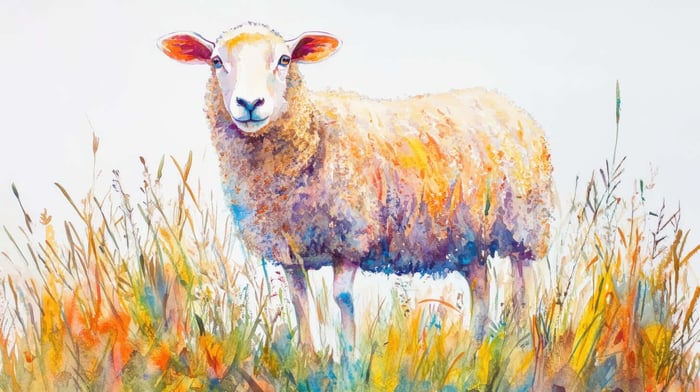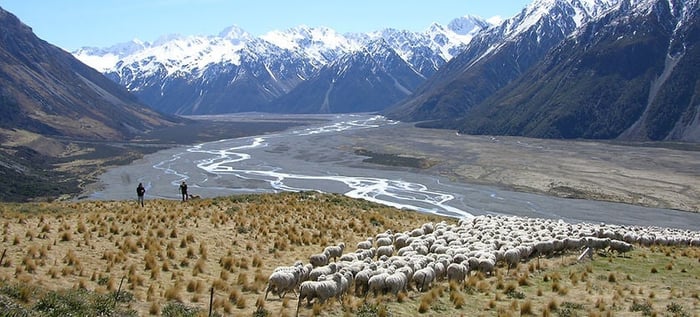Table of Contents
- What is Regenerative Wool?
- Why Regeneration Matters for the Way We Live
- Key Principles of Regenerative Wool
- How Regenerative Farming Differs from Industrial Agriculture
- Why We Chose Regenerative Wool
- From Farm to Fiber: The Journey of Regenerative Wool
- Environmental Impact of Our Wool
- Economic and Social Benefits
- How to Identify Genuine Regenerative Wool - Certification and Standards
- Challenges and Criticisms
- The Future of Regeneratively Produced Wool
- Why Regenerative Wool Matters for You
- Conclusion
- FAQs on Wool Duvet Inserts, Comforters & Sustainable Bedding
What is Regenerative Wool?
Picture this: rolling hills of green pasture, thriving soil beneath every hoofprint, and sheep grazing freely in balance with the land. That’s where regenerative wool begins — not in a factory, but in living, breathing ecosystems.
Unlike conventional wool, regenerative wool doesn’t just reduce harm; it helps heal the planet. It’s grown on farms that rebuild soil, capture carbon, and nurture biodiversity — creating fibers that are as kind to the earth as they are to your skin.
It’s the future of wool: softer, cleaner, and rooted in the belief that what we sleep under should also help the world rest a little easier.
So what exactly is regenerative wool? It's a sustainable approach to wool production that aims to minimize environmental impact while promoting animal welfare and soil health. This innovative method of wool farming goes beyond traditional practices by focusing on regenerating ecosystems, improving biodiversity, and capturing carbon dioxide from the atmosphere.
Imagine wool that not only warms you but also restores the planet—that’s the promise of regenerative wool. Let’s explore how this forward-thinking approach can reshape our understanding of sustainability.
Why Regeneration Matters for the Way We Live
The choices we make at home — even our bedding — ripple outward. Regenerative wool isn’t just about better fibers; it’s about restoring balance between people and planet. By choosing materials that heal the soil, protect animals, and support farmers, we help create a future where comfort and conscience coexist.
Key Principles of Regenerative Wool
1. Soil Health and Carbon Sequestration
Regenerative wool farming prioritizes soil health, which is crucial for carbon sequestration. By implementing practices such as rotational grazing and avoiding chemical fertilizers, farmers can:
- Improve soil quality.
- Increase the soil’s capacity to store carbon.
This approach not only helps mitigate climate change but also enhances the land’s resilience against drought and flooding. Healthy soils lead to healthier ecosystems, forming the foundation of regenerative farming.
Imagine a farmer working with nature, not against it. By letting sheep graze in a rotational pattern, they’re revitalizing the earth beneath their hooves while producing wool that carries a net-positive impact. Every step in this process brings us closer to a healthier planet.
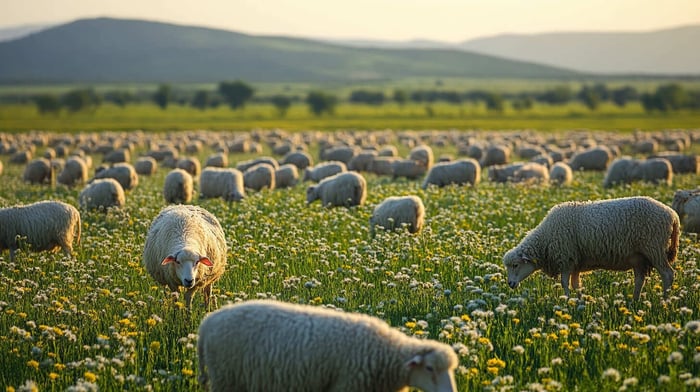 Regenerative farming begins here—sheep grazing naturally to restore soil health, biodiversity, and the balance that makes regenerative wool possible. Antipodean Home.
Regenerative farming begins here—sheep grazing naturally to restore soil health, biodiversity, and the balance that makes regenerative wool possible. Antipodean Home.2. Biodiversity Enhancement
Regenerative farm production fosters diverse ecosystems by:
- Promoting the growth of various plant species.
- Supporting wildlife through holistic land management.
This balanced and resilient environment benefits sheep, promotes healthier pastures, and strengthens the overall farm ecosystem. When you choose regenerative wool, you’re not just buying a product—you’re supporting the revival of entire landscapes teeming with life.
Picture a meadow, alive with vibrant flowers and buzzing with bees, where sheep graze freely. That’s the vision regenerative wool farming makes possible.
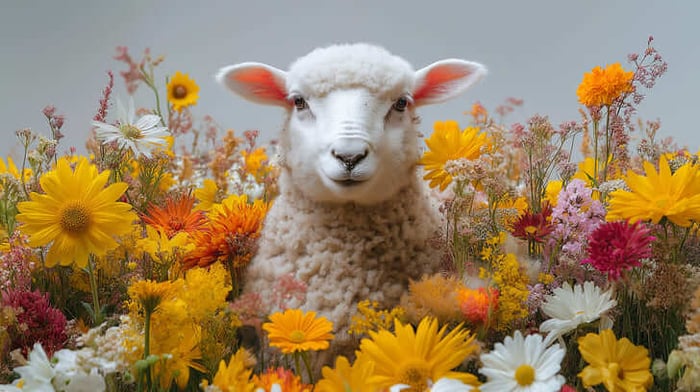 Regenerative wool starts with harmony—sheep grazing among thriving wildflowers that nurture soil health and biodiversity. Antipodean Home
Regenerative wool starts with harmony—sheep grazing among thriving wildflowers that nurture soil health and biodiversity. Antipodean Home3. Water Conservation and Management
Improved soil health directly impacts water cycles by:
- Increasing water retention in the soil.
- Reducing runoff and repairing erosion.
These practices help conserve water, reduce pollution, and ensure more efficient water use on farms. Think of regenerative wool as a product that’s also protecting one of our most precious resources—clean water.
By restoring natural water cycles, regenerative farming ensures that every drop counts. Imagine supporting products that actively contribute to saving water for future generations.
4. Animal Welfare
Regenerative wool production emphasizes animal welfare. Sheep are typically raised outdoors in pastures, allowing them to:
- Engage in natural behaviors.
- Experience reduced stress compared to industrial farming practices.
Healthy, stress-free animals produce better quality wool, further supporting sustainable practices. When you choose regenerative wool, you’re choosing compassion for animals.
Imagine sheep grazing peacefully under the open sky, their wool growing as a testament to humane and ethical care. This is the heart of regenerative wool.
How Regenerative Farming Differs from Industrial Agriculture
Picture two farms. On one side, a sprawling industrial operation churns out wool under tight, profit-driven schedules. The landscape is barren, stripped of its natural biodiversity, and the soil—depleted from years of chemical fertilizers and pesticides—offers little resilience to changing weather. Sheep are crowded into confined spaces, denied the ability to graze freely or interact naturally. The wool may be abundant, but it comes at a cost: a degraded ecosystem, high carbon emissions, and animals treated as commodities.
Now, step onto a regenerative wool farm. Here, the rhythm of nature guides every decision. Sheep roam freely on rotational pastures, their grazing patterns carefully managed to enrich the soil rather than deplete it. The land bursts with life—wildflowers, native grasses, and pollinators thrive alongside the livestock. Instead of chemical inputs, the farm relies on natural processes to restore soil health and capture carbon.
Farmers view themselves as stewards of the land, balancing production with the health of the ecosystem. The result? Wool that carries not just the story of its origins but the promise of a healthier planet.
Choosing regenerative wool means choosing a product that works with nature, not against it. It’s a decision to support a future where farming restores ecosystems rather than depleting them.
 Healthy soil is where regeneration begins—capturing carbon, restoring nutrients, and sustaining the wool that restores balance to our planet. Antipodean Home.
Healthy soil is where regeneration begins—capturing carbon, restoring nutrients, and sustaining the wool that restores balance to our planet. Antipodean Home.Why We Chose Regenerative Wool
At Antipodean Home, we believe in creating products that are not only comfortable but also kind to the planet. That’s why we source our wool from farmers certified through the ZQRX program. These farmers are pioneers in regenerative wool farming, implementing practices that enhance soil health, promote biodiversity, and prioritize animal welfare.
By choosing ZQRX-certified wool, we’re aligning with a community of farmers who are committed to sustainable practices. These farmers aren’t just producers; they’re stewards of the land, ensuring that their practices actively restore the environment for future generations.
When you wrap yourself in one of our comforters, you’re not just experiencing superior craftsmanship—you’re supporting a movement that values regeneration over exploitation. Regenerative wool embodies everything we stand for: quality, responsibility, and a brighter future.
From Farm to Fiber: The Journey of Regenerative Wool
Every thread begins on a regenerative farm — where sheep graze freely on diverse pastures and farmers track soil carbon and water cycles. That care continues through low-impact processing that keeps the wool’s natural properties intact. The result? Fibers that are cleaner, softer, and made with genuine respect for the planet.
Environmental Impact of Our Wool
1. Carbon Footprint Reduction
One of the most significant benefits of regenerative farming is its potential to reduce the carbon footprint of wool production. For example:
Some companies report that their regenerative wool sequesters more carbon than it emits. Sheep Inc., for instance, claims 1kg of their wool sequesters 14kg of CO2e, compared to conventional wool’s emission of over 25kg CO2e per kilogram.
By choosing regeneratively-farmed wool, you’re actively participating in the fight against climate change.
Your choices matter. Supporting regenerative farming means taking a stand for the planet, one kilogram of carbon at a time.
2. Methane Reduction
While sheep naturally produce methane, regenerative practices may help reduce emissions by:
- Capturing methane in soils.
- Altering sheep’s diet to minimize methane production.
More research is needed to fully quantify these effects, but early evidence is promising. Your support for regenerative farming fuels innovation in this area.
Imagine being part of a solution that transforms challenges like methane emissions into opportunities for a greener future.
Economic and Social Benefits
1. Improved Farmer Livelihoods
Sustainably regenerated wool farming can lead to better economic outcomes by:
- Reducing reliance on expensive inputs like chemical fertilizers.
- Enhancing profitability through healthier ecosystems and better-quality wool.
When you choose regeneratively produced wool, you’re supporting farmers who prioritize sustainability over short-term gains.
Think about the ripple effect—your purchase not only supports farmers but also inspires an entire industry to prioritize ethical and sustainable practices.
2. Community Support
Many regenerative programs provide training and resources to local farmers, fostering:
- Economic development.
- Improved social well-being in farming communities.
- Your purchase helps build stronger, more resilient communities.
Imagine communities thriving because of sustainable practices you choose to support. Regeneratively farmed wool creates stories of hope and progress.
How to Identify Genuine Regenerative Wool - Certification and Standards
Knowing what’s truly regenerative can be confusing — especially when so many brands use eco buzzwords without proof. Genuine regenerative wool is traceable from farm to finished fiber, backed by transparent data and verified standards. Here’s how to tell if the wool in your bedding really lives up to the promise of restoring the planet, not just sustaining it.
1. Responsible Wool Standard (RWS)
The RWS ensures wool comes from farms committed to progressive land management and animal welfare. While not specifically regenerative, it sets a solid foundation for responsible wool production.
2. NATIVA™ Regenerative Agriculture Program
Programs like NATIVA™ focus on improving soil quality, safeguarding animal welfare, and supporting local communities. By providing data and metrics, these initiatives help brands track progress and align with regenerative principles.
When shopping for wool, look for certifications like these to ensure your choices align with your values.
3. ZQRX: Science-Backed and Transparent
The ZQRX program stands apart due to its commitment to independent auditing and science-backed validation methods. Each participating farm is assessed against rigorous criteria to ensure they meet regenerative agriculture standards. These audits are conducted by third-party organizations, adding an essential layer of credibility and ensuring transparency in how claims are verified. From soil health metrics to animal welfare assessments, every aspect of the farm’s operations is evaluated with precision.
ZQRX also employs cutting-edge scientific methodologies to measure and track progress over time. This includes soil testing for carbon sequestration, biodiversity monitoring, and water management studies. By leveraging data-driven insights, the program provides tangible evidence of its environmental impact, offering consumers and brands a trustworthy foundation for their sustainability goals.
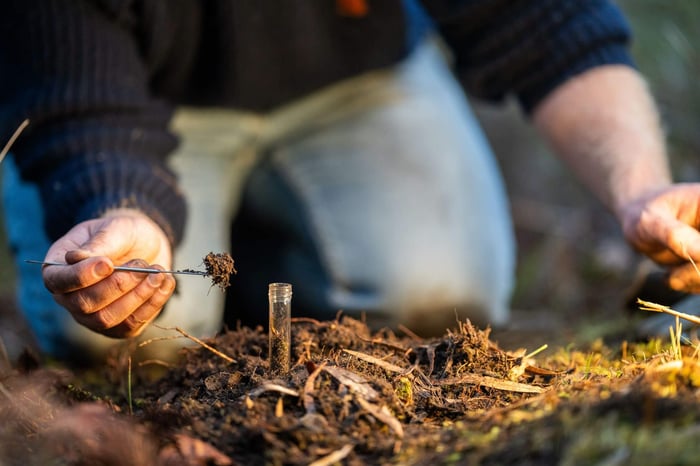 Regeneration starts beneath the surface—farmers measuring soil health to ensure every wool fiber begins in living, thriving earth. Antipodean Home.
Regeneration starts beneath the surface—farmers measuring soil health to ensure every wool fiber begins in living, thriving earth. Antipodean Home.Challenges and Criticisms
1. Need for More Research
Regenerative wool’s benefits require more robust scientific validation. Long-term studies are essential to accurately quantify its impact on emissions and carbon sequestration.
2. Greenwashing Concerns
Some companies may overstate the environmental benefits of regeneratively-farmed wool. Consumers should look for verified claims and certifications to avoid being misled.
3. Animal Welfare Debates
Despite improvements in animal welfare, some activists argue against using animals for clothing. This ethical debate continues within the sustainable fashion community.
Understanding these challenges empowers you to make informed decisions that align with your values.
The Future of Regeneratively Produced Wool
1. Industry Adoption
Major fashion brands like Patagonia and Stella McCartney are integrating regeneratively-farmed wool into their supply chains, promoting its benefits to environmentally conscious consumers.
Your support sends a powerful message to brands: sustainability is not a trend but a necessity.
2. Ongoing Research and Development
Organizations like Textile Exchange are investing in unified standards to promote and refine regenerative practices, ensuring widespread adoption and impact.
Why Regenerative Wool Matters for You
Every comforter or sheet made from regenerative wool supports cleaner air, healthier soil, and a cooler planet. It’s not just better for the earth — it’s better for your home. Naturally breathable, hypoallergenic, and chemical-free, regenerative wool helps you sleep deeper knowing your choices do good.
Conclusion
Wool grown via regenerative farming represents a significant shift in wool production by focusing on soil health, biodiversity, and animal welfare. While challenges remain, its potential to positively impact the environment and farming communities makes it a cornerstone of sustainable fashion’s future.
By supporting sustainably regenerated wool, you can be part of this transformative journey. Look for certified products, choose brands embracing these principles, and help build a better future for our planet. Together, we can create a wool industry that not only reduces its environmental footprint but actively restores ecosystems. The choice is in your hands—let’s make it count.
Imagine the warmth of wool that doesn’t just comfort you but comforts the Earth. That’s the power of regenerative wool—a choice for today and a hope for tomorrow.
Shop Our Regenerative Bedding Collection
FAQs on Wool Duvet Inserts, Comforters & Sustainable Bedding
What is regenerative wool?
Regenerative wool comes from farms that actively restore ecosystems through regenerative agriculture. These farms focus on soil health, carbon capture, biodiversity, and animal welfare — producing cleaner, more sustainable fibers that help heal the planet.
How is regenerative wool different from sustainable or organic wool?
While organic wool focuses on avoiding chemicals, regenerative wool goes further by rebuilding soil and capturing carbon. It’s a proactive approach that restores balance to ecosystems and improves land health over time.
Why does regenerative wool matter?
Because it helps reverse environmental damage. Every regenerative wool product supports practices that draw carbon from the atmosphere, protect waterways, and nurture biodiversity — turning everyday comfort into climate action.
Where does regenerative wool come from?
Much of the world’s regenerative wool is sourced from New Zealand and other regions where farmers follow science-backed programs like ZQRX. These farms measure progress in soil health, water quality, and animal welfare with full transparency.
Is regenerative wool better for your home and health?
Yes — it’s naturally hypoallergenic, breathable, and temperature-regulating. Regenerative wool bedding keeps you cool, dry, and toxin-free while helping restore the environment with every night’s sleep.

